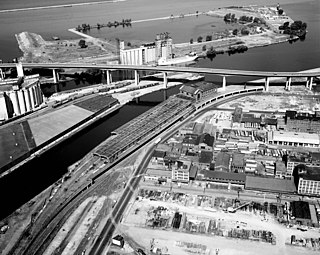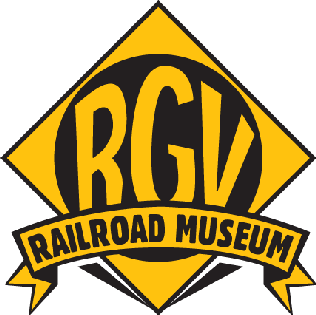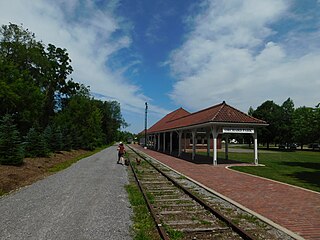
The Delaware, Lackawanna and Western Railroad, also known as the DL&W or Lackawanna Railroad, was a U.S. Class 1 railroad that connected Buffalo, New York, and Hoboken, New Jersey, and by ferry with New York City, a distance of 395 miles (636 km). The railroad was incorporated in Pennsylvania in 1853, and created primarily to provide a means of transport of anthracite coal from the Coal Region in Northeast Pennsylvania to large coal markets in New York City. The railroad gradually expanded both east and west, and eventually linked Buffalo with New York City.

Dearborn Station was, beginning in the late 1800s, one of six intercity train stations serving downtown Chicago, Illinois. It remained in operation until May 1, 1971. Built in 1883, it is located at Dearborn and Polk Streets, to the south of the Loop, adjacent to Printers Row. The station was owned by the Chicago & Western Indiana Railroad, which itself was owned by the companies operating over its line. The station building headhouse now houses office, retail, and entertainment spaces, and its trackage yard, behind the headhouse, was redeveloped into part of the Dearborn Park neighborhood.

For the purposes of this article, the Jersey City area extends North to Edgewater, South to Bayonne and includes Kearny Junction and Harrison but not Newark. Many routes east of Newark are listed here.

The Rochester Industrial and Rapid Transit Railway, more commonly known as the Rochester subway, was a light rail rapid transit line in the city of Rochester, New York that operated from 1927 to 1956. The subway was constructed in the bed of the old Erie Canal, which allowed the route to be grade-separated for its entire length. Two miles (3.2 km) of the route through downtown were constructed in a cut-and-cover tunnel that became Broad Street, and the only underground portion of the subway.

The Livonia, Avon and Lakeville Railroad is a short line railroad that operates in Livingston County and Monroe County in New York, United States. The railroad interchanges with CSX at Genesee Junction in Chili, New York, the Rochester and Southern Railroad (RSR) at Genesee Junction and the RSR's Brooks Avenue Yard in Gates, New York, and with the Rochester & Genesee Valley Railroad Museum at Industry, New York. Their primary freight consists of food products: grains and corn syrup. In 1997, the Livonia, Avon and Lakeville Railroad was selected as Short Line Railroad of the Year by industry trade journal Railway Age. The LAL is also the parent company for the Bath and Hammondsport Railroad, the Western New York and Pennsylvania Railroad and the Ontario Midland Railroad.

The Metro Rail Maintenance Yard or "South Park Terminal" houses Buffalo Metro Rail's cars in a train shed at the former Delaware, Lackawanna and Western Railroad terminal in the Cobblestone District of Buffalo, New York. The property is located at the southernmost fringe of the Central Business District. The station was built in 1917, and was designed to handle both steam trains and steamships. The storage and maintenance facility was converted to its present condition in 1982, following the demolition of the former main terminal concourse building "headhouse" of the DL&W Terminal in 1979.

The Central Railroad of New Jersey Terminal, also known as Communipaw Terminal and Jersey City Terminal, was the Central Railroad of New Jersey's waterfront passenger terminal in Jersey City, New Jersey. The terminal was built in 1889, replacing an earlier one that had been in use since 1864. It operated until April 30, 1967.

Westwood is an NJ Transit railroad station in Westwood, New Jersey. It is on the Pascack Valley Line and is located at Broadway and Westwood Avenue. The next station northbound, heading toward Spring Valley, New York, is Hillsdale. The next station southbound, headed for Hoboken Terminal, is Emerson. The station consists of one track, one low-level platform with a miniature high-level platform and a station depot maintained by the borough of Westwood. Westwood also maintains the parking lots, consisting of 226 parking spaces, six of which are accessible based on the Americans With Disabilities Act of 1990.

Hillsdale is an active commuter railroad station in the borough of Hillsdale, Bergen County, New Jersey. Servicing trains on New Jersey Transit's Pascack Valley Line, the station is located at the intersection of Broadway and Hillsdale Avenue. The next station to the north toward Spring Valley station is Woodcliff Lake and the next station to the south toward Hoboken Terminal is Westwood. The station contains one track while a single low-level side platform next to the station depot, resulting in no accessibility for handicapped persons under the Americans with Disabilities Act of 1990.

Park Ridge is an active commuter railroad station in the borough of Park Ridge, Bergen County, New Jersey. Located at the intersection of Park and Hawthorne Avenues, the station services trains on the Pascack Valley Line, which runs from Hoboken Terminal to Spring Valley station in New York. The station contains a single low-level side platform split by Park Avenue and a wooden station depot, built by the Hackensack and New York Extension Railroad. As a result, Park Ridge station is not handicap accessible under the Americans with Disabilities Act of 1990.

The Louise M. Slaughter Rochester Station is an Amtrak intermodal transit station in Rochester, New York. Local and regional bus transportation is provided by the Rochester-Genesee Regional Transportation Authority. Various taxi firms service the station, as well. The station is located on the north side of Rochester, just east of High Falls on the south side of the tracks.

Ridgewood is a railroad station operated by New Jersey Transit in the village of Ridgewood, Bergen County, New Jersey, United States. A major transfer station, Ridgewood has two high-level platforms for the Main Line and Bergen County Line.

Allendale is a NJ Transit rail station served by its Main and Bergen County lines as well as Port Jervis Line trains. The station is located at the railroad next to Allendale, Park and Myrtle avenues in Downtown Allendale. The station consists of two low-level platforms serving trains heading between Hoboken Terminal and Suffern. Some westbound trains headed for Port Jervis also stop at Allendale. The station has two ticket vending machines along the inbound platform with three parking lots for commuters. The railroad depot, constructed in 1870, is a combined passenger and freight depot, with a waiting area for passengers at the south end of the building while the northern end is unused.

The Rochester and Genesee Valley Railroad Museum (RGVRRM) is an operating railroad museum located in Industry, New York, a hamlet within the town of Rush. The museum started in 1971 with the purchase of a former Erie Railroad Depot from the Erie Lackawanna Railroad. Since then the museum has grown to include a one-mile demonstration railroad, connecting it with the New York Museum of Transportation in Rush, making it one of the few operating railroad museums in New York State.

Orchard Park station is a historic railway station located at Orchard Park in Erie County, New York. It was constructed in 1911 and served passenger trains until the 1950s.

Anderson Street is a New Jersey Transit rail station on the Pascack Valley Line. The station is one of two rail stations in Hackensack and located at Anderson Street near Linden Street.
The Rochester, Lockport and Buffalo Railroad was an electric interurban railway that was constructed between Rochester, New York, and Lockport, New York, connecting to the International Railway Co. at Lockport for service into Buffalo. Opened in 1909 as the Buffalo, Lockport and Rochester Railway, the route followed the Erie Canal and the New York Central Railroad's Falls Road branch for most of its length. The direct route took a little over two hours to travel from Lockport from Rochester. Most trains were local routes and took 2 hours 35 minutes. There were trains between the main stations every hour, however there were trains between Rochester and Brockport every 30 minutes and sometimes every 15 minutes. For a brief period of time, the railway was part of the Beebe Syndicate of affiliated interurban railways stretching from Syracuse to Buffalo. Entering receivership in 1917, it was reorganized as the Rochester, Lockport and Buffalo Railroad in 1919. After years of struggling with declining revenue during the Depression years, the railway's last day of service was April 30, 1931.

Erie Railroad Depot, Erie Railroad Station or Erie Depot was the terminal station for the Erie Railroad in Rochester, New York, designed by George E. Archer, the railroad's architect.
The Operating Passenger Railroad Stations Thematic Resource is a list of 53 New Jersey Transit stations in New Jersey entered into the New Jersey Register of Historic Places and National Register of Historic Places in 1984 for their architectural, historical, and cultural merit.

Kent is a former station for the Erie Railroad in Kent, Ohio, on the Erie main line between Chicago and Jersey City. Along the main line, the next station west towards Chicago’s Dearborn Station was Tallmadge, while east towards Jersey City’s Pavonia Terminal was Ravenna. The station was located 615.9 miles (991.2 km) from Pavonia Terminal and 382.6 miles (615.7 km) from Dearborn Station. The city of Kent was the headquarters of the Kent Division, with car shops and a large yard maintained just south of the station until 1930. About one mile (1.6 km) north of the station were the Erie Railroad's Breakneck Yards, which operated into the 1960s.




























